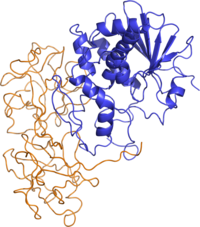
Photo from wikipedia
ABSTRACT The application of mung bean protein in foods is limited due to its poor functionality. Acylation with succinic anhydride could be used to improve the functionalities of protein. In… Click to show full abstract
ABSTRACT The application of mung bean protein in foods is limited due to its poor functionality. Acylation with succinic anhydride could be used to improve the functionalities of protein. In this study, the influence of the weight ratio of succinic anhydride to protein (0–0.10) on the degree of N-acylation, physicochemical properties and protein functionalities including emulsifying properties of mung bean protein isolates (MPI) were investigated. The extent of N-acylation of MPI increased as the succinic anhydride:protein ratio increased, while the ζ-potential at neutral pH decreased. In addition, succinylation had an impact on the average particle size of MPI depending on the succinic anhydride:protein ratio. Succinylation had no impact on the total and exposed free sulfhydryl groups. Moreover, the isoelectric point (pI) of the succinylated proteins shifted from pH 5 to lower pH. Succinylation increased the emulsifying activity index (EAI), while the impact on the emulsion stability index depended on the succinic anhydride:protein ratio. Thus, succinylation at low succinic anhydride:protein ratio can alter mung bean protein charge and affect physicochemical and functional properties especially emulsifying properties that could be used to increase its utilization.
Journal Title: International Journal of Food Properties
Year Published: 2018
Link to full text (if available)
Share on Social Media: Sign Up to like & get
recommendations!